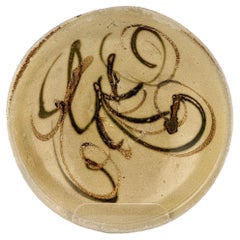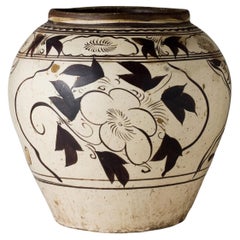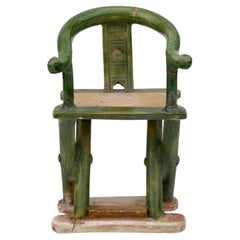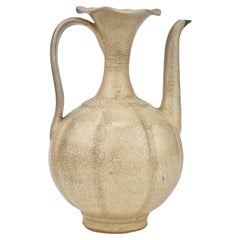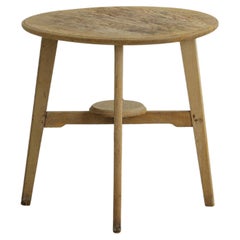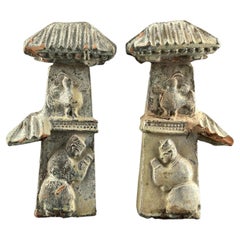Asia - Antiquities
to
463
773
882
423
759
13
1
2
1
1
423
174
162
14
116
12
1
1
1
1
1
1
337
303
148
103
64
754
457
293
209
160
773
770
770
10
Item Ships From: Asia
Changsha Bowl from Belitung Ship, Tang Period
Located in seoul, KR
The back side edges have been dipped in four places with brown, probably iron-oxide. The well of the bowl is freely painted in deep green and coffee coloured brown. These are charact...
Category
15th Century and Earlier Indonesian Tang Antique Asia - Antiquities
Materials
Pottery
$1,950 Sale Price
35% Off
Large Cizhou Jar, Yuan Dynasty
Located in seoul, KR
This vase is sturdily potted with a robust ovoid body that rises from a short, spreading foot to a gently tapering neck, finishing with a lipped mouth rim. The exterior is decorated ...
Category
15th Century and Earlier Hong Kong Antique Asia - Antiquities
Materials
Pottery
$4,495 Sale Price
50% Off
16th Century Pottery Model of a Folding Chair, Ming dynasty
Located in seoul, KR
This piece is an example of Mingqi, items specifically crafted for burial to accompany the deceased into the afterlife. The terracotta army is the most renowned example of such buria...
Category
16th Century Hong Kong Ming Antique Asia - Antiquities
Materials
Pottery
$903 Sale Price
35% Off
Rare annamese cream glazed ewer, Vietnam, 11-15th century
Located in seoul, KR
Famous annamese cream glazed ceramic ewer covered with a cream glaze. Traces of excavation are clearly visible in the glaze.
Dates : Presumably Ly Dynasty (11-13th century)
Region ...
Category
15th Century and Earlier Vietnamese Antique Asia - Antiquities
Materials
Ceramic, Stoneware
Japanese Antique Table, Early 20th Century
Located in Katori-Shi, 12
Introducing an exceptional round table that can be said to be the culmination of Taisho-era craftsmanship.
It features tapered legs that narrow towards the base, giving it a delica...
Category
Early 20th Century Japanese Taisho Asia - Antiquities
Materials
Wood
Gate Pillar, Han Dynasty(206BC-220AD)
Located in seoul, KR
The Han Dynasty gate pillar held by the Asian Art Museum in San Francisco and this gate pillar are the only known examples of their type worldwide, highlighting its extraordinary rar...
Category
15th Century and Earlier Hong Kong Han Antique Asia - Antiquities
Materials
Earthenware
$5,985 Sale Price / set
25% Off
Three Annamese Small Blue Lidded Boxes, 15th century, Le Dynasty
Located in seoul, KR
These are three small lidded boxes from the Vietnamese period, specifically from the 15th century during the Le Dynasty.
Dates : 15th century Le Dynasty
Region : North Annam, Viet...
Category
15th Century and Earlier Vietnamese Antique Asia - Antiquities
Materials
Ceramic
$954 Sale Price / set
40% Off
Earthenware Pottery Jar, Han Dynasty(206 BC-220 AD)
Located in seoul, KR
This jar would have served as a mortuary object (mingqi), placed in a tomb as a substitute for the more valuable bronze and lacquer vessels. Along with a variety of other funerary earthenware objects, attendant figures, and animals, richly decorated vessels of this kind were intended to serve the spirit of the deceased in the afterlife.
Period : Han dynasty
Type : Jar
Medium : Earthenware
Dimension : 28.5 cm(Height) x 11cm(Mouth Diameter)
Condition : Good(Overall in well-preserved ancient burial condition with some soil still adhering (showing minor abrasions and wear due to prolonged burial underground)
Provenance : Acquired in late 1990s from Hongkong
* Han Dynasty Earthenware...
Category
15th Century and Earlier Hong Kong Han Antique Asia - Antiquities
Materials
Earthenware
$2,093 Sale Price
30% Off
Antique Small Chest of Drawers from 19th Century, Japan
Located in Tokyo, Tokyo
Antique small chest of drawers from Edo period (1603-1868), Japan.
Because of its age, the chest shows signs of use, which in turn make...
Category
19th Century Japanese Antique Asia - Antiquities
Materials
Iron
Qingbai Lotus Censer, Song Dynasty
Located in seoul, KR
This exquisite Qingbai piece, acquired in Hong Kong in the late 1990s, is a high-quality artifact from the Southern Song Dynasty, likely produced at the Hutian Kiln. The base exhibit...
Category
15th Century and Earlier Hong Kong Antique Asia - Antiquities
Materials
Ceramic
$10,000 Sale Price
50% Off
Japanese Primitives Antiques : Hearth Tools Fish-shaped wood Hook Farmer Life
Located in Niiza, JP
A tool used to hang a kettle from the ceiling above a hearth is called a Jizai-kagi(自在鉤).
This is a part called a Yokogi(横木) that is used to adjust the length of the hook.
It has bee...
Category
18th Century Japanese Antique Asia - Antiquities
Materials
Wood
Japanese Antique Flower Stand, Early 20th Century
Located in Katori-Shi, 12
Introducing a pinnacle of Japan's Taisho era furniture, this piece exemplifies meticulous craftsmanship akin to sculptural artistry. Adorned with intricate decorations reminiscent of...
Category
Early 20th Century Japanese Taisho Asia - Antiquities
Materials
Wood, Cherry
Cizhou slender meiping, Yuan Dynasty
Located in seoul, KR
The elongated body is fluidly painted in brown on a white slip and under a clear glaze with a broad band of abstract floral scroll between a band of upright petals below and further ...
Category
15th Century and Earlier Hong Kong Other Antique Asia - Antiquities
Materials
Stoneware
$7,996 Sale Price
60% Off
Rare Yue Celadon Chicken-Head Ewer, Jin-Southern Dynasty
Located in seoul, KR
Chicken-head ewers are among the most distinct and emblematic pottery pieces from the Han (206 BC - AD 220) to the Tang (618-907) dynasties. Their production commenced during the Jin...
Category
15th Century and Earlier Hong Kong Han Antique Asia - Antiquities
Materials
Celadon, Stoneware
$7,160 Sale Price
60% Off
Teapots with Cover from Ca Mau Ship, Qing Dynasty, Yongzheng Reign
Located in seoul, KR
The teapot on the left features a rounded body densely adorned with blooming flowers and intertwining vines, creating a flowing and repetitive pattern. The delicate brushstrokes emph...
Category
18th Century Vietnamese Qing Antique Asia - Antiquities
Materials
Ceramic
$1,820 Sale Price / set
35% Off
Funerary Model of a Granary, Han dynasty
Located in seoul, KR
Cylindrical vessel on three animal-shaped feet (dragon or snake), wall with profile grooves, roof. pottery with green lead glaze. "Iridescence" is observed in surface.
Period : Han...
Category
15th Century and Earlier Hong Kong Han Antique Asia - Antiquities
Materials
Pottery
$1,400 Sale Price
30% Off
Two Glazed Court Attendants, Ming Period (1368-1644)
Located in seoul, KR
Two finely hollow-moulded terracotta statuettes from ancient China, dating to the Ming Dynasty. The figure is depicted standing, dressed in long, flowing robes, painted in vibrant blue or green and deep amber yellow. The hair is styled into an elaborate top-knot, painted in a muted brown. Areas left unpainted would have been 'cold-painted' after firing, contrasting with the vivid fired blue or green and amber pigments. The figure is shown with the left hand raised to the chest, as if holding something, possibly an offering or incense. Figurines like this were placed in tombs to guide the deceased on their journey to the afterlife.
The Ming Dynasty was known for its exceptional artistic achievements, partly due to its economic prosperity. Since the Han Dynasty, it was customary to bury terracotta miniatures of everyday objects with the deceased. These items, known as mingqi, or "spirit utensils" and "vessels for ghosts," were believed to help and assist the deceased in the afterlife. Mingqi were crafted in the form of cooking utensils, miniature replicas of houses, temples, furniture, and other items. Anthropomorphic and zoomorphic terracotta figures were also popular, designed to assist, entertain, and recreate the living world for the deceased.
Period: Ming Dynasty
Medium: Green/blue-glazed Pottery
Type: Figure
Provenance : Acquired in late 1990s from Hongkong
Reference :
1) Ancient & Oriental - Terracotta Tomb Attendants
(Type : Highly related)
2) La Maison De La Petite Sara S.r.l. - Archaeology section - A Black glazed Terracotta Statuette, Servant with Trumpet, Ming Dynasty
(Price realised : 700 GBP / Type : Highly related)
* Ming Dynasty Glazed Pottery Figures
Ming Dynasty glazed pottery figures are renowned for their bold color palette, intricate detailing, and lifelike forms, distinguishing them from earlier traditions. These figures, which depict officials, warriors, animals, and mythical creatures, are characterized by high-gloss lead-based glazes in green, amber, ochre, and sancai (three-color) combinations. The thickly applied glaze pools in recesses, creating depth and enhancing sculptural details. With dynamic postures, expressive facial features, and meticulously rendered drapery, these figures reflect the period’s advancement in ceramic craftsmanship, offering a greater sense of movement and realism compared to the rigid and stylized forms of earlier dynasties.
A defining characteristic of Ming glazed pottery is its elaborate surface detailing, often achieved through raised relief elements and contrasting glazes. Equestrian figures, for example, feature carefully sculpted saddles, harnesses, and decorative embellishments, while human figures are adorned with intricate robes and headdresses. The large scale of these tomb figures, often more imposing than those from previous periods, underscores the increasing importance of funerary art during the Ming era. Unlike later Qing Dynasty figures...
Category
15th Century and Earlier Hong Kong Ming Antique Asia - Antiquities
Materials
Pottery
$1,943 Sale Price / set
35% Off
Large Yue Globular Stoneware Jar, Han Dynasty-Three Kingdoms
Located in seoul, KR
Robustly crafted with a voluminous spherical body and a layered mouth rim, this jar features a pair of taotie handles. It is adorned with three horizontal bands on the upper half of ...
Category
15th Century and Earlier Hong Kong Han Antique Asia - Antiquities
Materials
Stoneware
$2,793 Sale Price
30% Off
Annamese Dish Circa 15th Century, Le Dynasty
Located in seoul, KR
Its surface is coated with a smooth, glossy white or cream-colored glaze, exuding a clean and elegant finish. At the center, a geometric motif painted in black pigment draws the eye,...
Category
15th Century and Earlier Vietnamese Antique Asia - Antiquities
Materials
Stoneware
$1,500 Sale Price
40% Off
Blue and White Baluster Vase, Qing Dynasty, Kangxi Era, Circa 1690
Located in seoul, KR
The baluster shaped vase rising from a splayed foot to a short waisted neck, decorated in underglaze blue with flower blooms borne on leafy stems.
Period : Qing Dynasty, Kangxi reign
Production Date : 1690-1699
Made in : Jingdezhen
Destination : Amsterdam
Found/Acquired : Southeast Asia , South China Sea, Vung Tau...
Category
1690s Vietnamese Chinoiserie Antique Asia - Antiquities
Materials
Ceramic
Large Pottery Standing Figure of Attendant, Han dynasty
Located in seoul, KR
The statuette shows traces of the original red, black, and white pigmentation. The figure’s body, head, and hands (which in this case are lost) were all made separately to give her an essence of movement and dynamism. Given its almost identical shape to the piece from the Artemis Gallery...
Category
15th Century and Earlier Hong Kong Han Antique Asia - Antiquities
Materials
Pottery
$2,334 Sale Price
34% Off
'Peacock in Splendour' Pattern Dish, c1725, Qing Dynasty, Yongzheng Era
Located in seoul, KR
A representative piece of Ca Mau ship. With a tall peacock standing on a rocky outcrop displaying his feathers to a peahen who crouches on the ground before him...
Category
1720s Vietnamese Chinoiserie Antique Asia - Antiquities
Materials
Ceramic
$3,894 Sale Price
34% Off
Green Glazed Horse and Rider, Ming period(15-16th Century)
Located in seoul, KR
Statues of East Asian horse rider, featuring glazes in green, are set on rectangular base.
Period: Ming Dynasty
Medium: Green-glazed Pottery
Type: Figure
Condition : Good
Provenance : Acquired in early 2000s from Hongkong
* Ming Dynasty Glazed Pottery Figures
Ming Dynasty glazed pottery figures are renowned for their bold color palette, intricate detailing, and lifelike forms, distinguishing them from earlier traditions. These figures, which depict officials, warriors, animals, and mythical creatures, are characterized by high-gloss lead-based glazes in green, amber, ochre, and sancai (three-color) combinations. The thickly applied glaze pools in recesses, creating depth and enhancing sculptural details. With dynamic postures, expressive facial features, and meticulously rendered drapery, these figures reflect the period’s advancement in ceramic craftsmanship, offering a greater sense of movement and realism compared to the rigid and stylized forms of earlier dynasties.
A defining characteristic of Ming glazed...
Category
15th Century and Earlier Hong Kong Ming Antique Asia - Antiquities
Materials
Pottery
$1,625 Sale Price
35% Off
Blue and White Porcelain Meiping Vase with Peony Scroll, Ming Dynasty
Located in seoul, KR
This piece is presumed to be a blue and white porcelain meiping vase from the mid-Ming Dynasty. The entire body is decorated with arranged peony scrolls painted in underglaze cobalt blue. The vivid yet dark navy tone of the cobalt pigment suggests it may have been produced using pigment typical of the early to mid-Ming period.
The decorative bands, such as the cloud motifs and the lotus petal patterns, contribute to the overall sense of proportion and harmony. The intricate brushwork and density of the design indicate a skilled artisan’s hand. The balanced form and the shape of the foot provide clues for dating the piece.
Period: Mid-Late Ming Dynasty
Medium: Blue and White Porcelain
Type: Meiping
Size : 3.5cm(Mouth Diameter), 27cm(Height)
Provenance : Acquired in late 1990s from Hongkong
Reference : Sotheby's Paris 10 December 2019 - VASE EN PORCELAINE BLEU BLANC...
Category
16th Century East Asian Ming Antique Asia - Antiquities
Materials
Ceramic
$3,250 Sale Price
35% Off
Japanese Antique Small Chests of Drawers , Tansu, Wabi-Sabi
Located in Katori-Shi, 12
This storage box with drawers was made during the Taisho period(1900-1926).
The base is made of light and durable paulownia wood, and the drawers are made of cherry wood.
The beaut...
Category
Early 20th Century Japanese Taisho Asia - Antiquities
Materials
Wood
Japanese Antique Wooden Bowl 1910s-1930s Primitive Wabi-Sabi
Located in Chiba, Chiba
This is an old Japanese wooden bowl with legs.
The wooden bowl is dyed black.
It is likely that this was made as a manger.
However, there is no evidence that it was ever used, so I ...
Category
Early 20th Century Japanese Primitive Asia - Antiquities
Materials
Wood
$400 Sale Price
38% Off
Japanese Antique Coffee Table, Primitive, Wabi-Sabi, Early 20th Century
Located in Katori-Shi, 12
A Japanese antique furniture coffee table produced in the Taisho period.
It was made by applying traditional techniques used in Japanese shrin...
Category
Early 20th Century Japanese Taisho Asia - Antiquities
Materials
Oak
Han Dynasty, Antique Chinese Painted Pottery Cocoon Jar
Located in Sampantawong, TH
Antique Chinese painted pottery cocoon jar with original pigments remaining.
The cocoon jar is sometimes called a "duck-egg jar", used as a wine vessel during Han Dynasty.
Age: Ch...
Category
15th Century and Earlier Chinese Antique Asia - Antiquities
Materials
Pottery
Ten Auspicious Korean Traditional Embroidered Pillows
Located in seoul, KR
Ten traditional embroidered pillows given by a bride to her husband as part of her dowry during marriage in Korea's modern era. These embroidered designs convey auspicious messages r...
Category
19th Century Korean Antique Asia - Antiquities
Materials
Fabric
$1,950 Sale Price
35% Off
An Exceptional Gilt-Bronze Dragon, Presumably Six Dynasties
Located in seoul, KR
An art piece presumably from the Six Dynasties period in China, spanning from the 3rd to the 6th centuries. This era is known for its political fragmentation but also significant cul...
Category
15th Century and Earlier Hong Kong Antique Asia - Antiquities
Materials
Bronze
$16,250 Sale Price
35% Off
19th Century Rare Bronze Buddha Statue, Thailand
Located in Fukuoka, JP
Rare Bronze Buddha Statue in Blessing Posture - Royal Bangkok Art Style
Introducing a truly extraordinary find, this rare Bronze Buddha statue...
Category
19th Century Thai Antique Asia - Antiquities
Materials
Bronze
Japanese Antique flower stand, Wabi-Sabi, Japandi
Located in Katori-Shi, 12
This flower stand has an attractive, clean appearance.
The gentle curves of the front board give a soft impression to the simple structure.
The rounded design of the legs also adds ...
Category
Early 20th Century Japanese Taisho Asia - Antiquities
Materials
Wood
Rare and Unusual Edo-Period Wooden Brazier Hook – 19th Century
Located in Fukuoka, JP
An exceptionally rare and unusual large wooden brazier hook (jizaikagi), dating to the Edo–Meiji period (19th century). Traditionally used in the homes of wealthy farmers, these scul...
Category
19th Century Japanese Edo Antique Asia - Antiquities
Materials
Wood
A Straw-Glazed Pottery Figure of a man on Horseback, Sui to Tang Dynasty
Located in seoul, KR
The rider is seated upright, wearing a smoothly draped robe with finely sculpted folds. The red markings on the garment surface are likely either soil deposits or remnants of pigment...
Category
15th Century and Earlier Hong Kong Tang Antique Asia - Antiquities
Materials
Pottery, Straw
$975 Sale Price
35% Off
1920-1940s Rare Japanese Imperial Army Officer Hat with Storage Box
Located in Fukuoka, JP
A Rare Japanese Imperial Army Officer Hat with Original Metal Box.
This rare Japanese Imperial Army officer hat is a stunning example of Japanese mi...
Category
20th Century Japanese Taisho Asia - Antiquities
Materials
Wool
Qingbai Melon form water ewer, Five Dynasties-Northern song dynasty
Located in seoul, KR
The oviform body is divided into few lobes, and the shoulder is applied with a pair of small loops molded.
Period : Five Dynasties-Song Dynasty(907~1279)
Type : Ewer
Medium : Zheji...
Category
15th Century and Earlier Hong Kong Antique Asia - Antiquities
Materials
Porcelain
$1,495 Sale Price
50% Off
Japanese Antique Table, Early 20th Century
Located in Katori-Shi, 12
This is a compact round table that flares out at the end.
It has tapered legs that become thinner towards the base, giving it a delicate and elegant appearance despite its neat, una...
Category
Early 20th Century Japanese Taisho Asia - Antiquities
Materials
Wood
Small Qingbai Pear-Shaped Vase, Song-Yuan Dynasty(13-14th century)
Located in seoul, KR
This exquisite piece is a Qingbai ware from the Song to Yuan dynasty, and it appears to be an excavated artifact given its earthy encrustations, suggesting it has rested in the groun...
Category
15th Century and Earlier Hong Kong Antique Asia - Antiquities
Materials
Ceramic, Porcelain
$895 Sale Price
50% Off
Green-Glazed Pottery Elephant, Han dynasty
Located in seoul, KR
This piece is an elephant statue made of green-glazed pottery. During the Han Dynasty, artworks depicting elephants were quite rare. However, such representations did occasionally appear. For example, the bronze vessel from the Han Dynasty housed in the Shanghai Museum is one of the notable examples of this type of craftsmanship. The existence of elephants in ancient China is attested both by archaeological evidence and by depictions in Chinese artwork. Long thought to belong to an extinct subspecies of the Asian elephant named Elephas maximus...
Category
15th Century and Earlier Hong Kong Han Antique Asia - Antiquities
Materials
Pottery
$3,742 Sale Price
25% Off
Wooden Display Stand, Bonsai Stand, Object, Japanese Antique, Wabi-Sabi
Located in Katori-Shi, 12
This is an antique display stand made from old wood from the Taisho era.
In Japan, it was used as a stand for Bonsai.
It is made of cherry wood and features a lacquer finish.
It gives you a sense of the powerful grandeur of nature and has a timeless dignity.
This display stand can be used in a wide variety of ways, including as a display stand, flower stand, bonsai stand...
Category
Early 20th Century Taisho Asia - Antiquities
Materials
Wood
18th Century, Shan, Antique Burmese Wooden Seated Buddha
Located in Sampantawong, TH
Antique Burmese wooden Buddha sitting in Mara Vijaya (calling the earth to witness) posture on a base.
Age: Burma, Shan Period, 18th Century
Size: Height 58 C.M. / Width 20 C.M. / D...
Category
18th Century Burmese Antique Asia - Antiquities
Materials
Wood
Japanese Antique Bamboo basket Folk art Wabi-Sabi
Located in Chiba, Chiba
This bamboo basket is made by combining bamboo of various shapes.
It is a folk craft item made by hand by people in the past.
It is made of bamboo so it is very lightweight.
The bamb...
Category
Early 20th Century Japanese Asia - Antiquities
Materials
Bamboo
Japanese Antique Wooden Bowl 1910s-1940s Primitive Wabi-Sabi
Located in Chiba, Chiba
This is a Japanese wooden bowl.
It is a folk craft that was used in daily life.
I don't know what kind of wood it's made of, but it's sturdy.
Since it is made by hand, it has a dist...
Category
Early 20th Century Japanese Asia - Antiquities
Materials
Wood
$300 Sale Price
40% Off
Yanyan Vase from Vung Tau Ship, Qing Dynasty Kangxi Era, Circa 1690
Located in seoul, KR
Each side pencil-painted with stylized chrysanthemum, lotus or daisy sprays issuing from rockwork. This blue and white square vase with rounded sides has a flaring mouth and a long neck. This shape can be traced back to Chinese bronzes. It is decorated with floral motifs on four sides in underglaze blue.
This piece was originally part of a pair, but the other has already been sold.
Period : Qing Dynasty, Kangxi Period(1690-1699)
Origin : Jingdezhen
Destination : Netherland
Found/Acquired : Southeast Asia , South China Sea, Vung Tau Ship
Reference : Double checked with reference to the original catalogues below
1) Christies Amsterdam 1992 - Vung Tau Cargo...
Category
17th Century Vietnamese Antique Asia - Antiquities
Materials
Ceramic
$2,310 Sale Price
30% Off
Lang Yao Water Coupe, Qing Period
Located in seoul, KR
This ceramic piece features a low, rounded form with a narrow mouth, exemplifying refined simplicity and balance. The surface is covered in a rich, deep crimson glaze, likely derived...
Category
18th Century East Asian Qing Antique Asia - Antiquities
Materials
Ceramic
$1,500 Sale Price
25% Off
A Russet-Splashed Blackish-Brown-Glazed Jar, Song Dynasty
Located in seoul, KR
Lustrous blackish-brown glaze decorated on the exterior with lines of splashes of russet color. This jar features a rounded and voluminous body, with its shoulders gently curving upward to meet the lid. The lid is topped with a small knob-like handle at the center, creating a harmonious and well-balanced overall proportion.
Under microscopic magnification, the brown-glazed...
Category
15th Century and Earlier Hong Kong Antique Asia - Antiquities
Materials
Ceramic
$8,775 Sale Price
35% Off
A Rare Sancai-Glazed Pottery Jar, Tang Dynasty
Located in seoul, KR
The jar is of globular shape and is decorated to the body with a geometric design band of lozenge-shaped motifs in blue, green, ochre and cream below a plain ochre everted mouth rim,...
Category
15th Century and Earlier Hong Kong Tang Antique Asia - Antiquities
Materials
Earthenware
$7,950 Sale Price
50% Off
Rare Boshan Incense Burner Yue Celadon, Jin dynasty
Located in seoul, KR
The Boshan incense burner is particularly notable among Han dynasty incense burners for its unique shape. Designed to resemble a mountain or even a mythical mountain, it is characterized by its pointed peaks that rise upwards. These peaks often function as vents for the smoke, creating an effect reminiscent of a volcanic eruption.
The body of the incense burner is typically round, with multiple small peaks surrounding a central, larger peak. The material used is mainly ceramic, although there are instances where they were made of bronze. It is presumed that this incense burner was used for religious or ceremonial purposes during its time. The colors of these burners are usually in shades of pale green or greyish brown, with the application of glaze to achieve a variety of colors on occasion.
Such incense burners are often found in tombs or ritual sites, and their purpose was to burn incense for purification of space or to produce pleasant aromas. The Boshan incense burner also represents a significant cultural heritage, showcasing the craftsmanship and artistic values of the period. Today, it is considered a quintessential example of ancient Chinese art.
Period : Han-Jin Dynasty
Type : Incense Burner
Medium : Yue celadon...
Category
15th Century and Earlier Hong Kong Han Antique Asia - Antiquities
Materials
Stoneware
$5,960 Sale Price
60% Off
Pair of Qingbai Vases, Song-Yuan Dynasty
Located in seoul, KR
This pair of Qingbai vases features a soft bluish-green glaze with elegant, fluted bodies and wide, flared rims. The vases are hand-crafted, with subtle differences that highlight th...
Category
15th Century and Earlier Hong Kong Antique Asia - Antiquities
Materials
Porcelain
$2,183 Sale Price / set
44% Off
Three Blue and White Miniature Vases Set, C 1725, Qing Dynasty, Yongzheng Era
Located in seoul, KR
* Set Item(3 vases)
During Yongzheng era, such miniatures were appreciated for their craftsmanship and aesthetic value. They were also often used in scholars' studios as part of the...
Category
1720s Vietnamese Qing Antique Asia - Antiquities
Materials
Ceramic
Chinese Famille Rose/Verte 'Fish' Dish, Qing Dynasty
Located in seoul, KR
During the Qing Dynasty, depictions of fish on ceramics carried several symbolic meanings. Fish are traditionally associated with abundance and prosperity in Chinese culture. The wor...
Category
17th Century Vietnamese Qing Antique Asia - Antiquities
Materials
Ceramic, Porcelain
$1,228 Sale Price
35% Off
Amber-Glazed Pottery Figure of Dog, Tang-Liao Dynasty (7-12th Century)
Located in seoul, KR
A Dog sitting on his haunches, covered in an amber glaze. Naturalistically modeled, the figure follows the artistic style of the period. It remains uncertain whether the glaze has wo...
Category
15th Century and Earlier Hong Kong Tang Antique Asia - Antiquities
Materials
Pottery
$1,943 Sale Price
35% Off
Two Green glazed Figures Holding Pitchpork, Han dynasty
Located in seoul, KR
Han dynasty pottery tomb figure, modelled standing holding a Pitchpork in front of his body, covered in a turquoise-green glaze. These two pieces are believed to have been produced i...
Category
15th Century and Earlier Hong Kong Han Antique Asia - Antiquities
Materials
Pottery
$2,227 Sale Price / set
25% Off
Neolithic Pottery Amphora(Gansu Province), 3rd-2nd Millenium BC
Located in seoul, KR
Neolithic Jar with strap handle from Gansu Province. Acquired in Hong Kong in the late 1990s.
Date : 3,000-2,000 BC
Made in : Gansu province
Dimension : 23cm (Height) x 8.5cm(Mouth ...
Category
15th Century and Earlier Hong Kong Antique Asia - Antiquities
Materials
Earthenware, Pottery
$2,275 Sale Price
35% Off
Small Celadon Chrysanthemum Dish, Northern Song Dynasty(AD 960~1127)
Located in seoul, KR
Potted with the fluted sides rising from a recessed base, carved to the interior with Chrysanthemum, covered overall with a grayish-green glaze, save for a ring to the underside left unglazed to reveal the gray stoneware...
Category
15th Century and Earlier Hong Kong Ming Antique Asia - Antiquities
Materials
Celadon
$3,185 Sale Price
35% Off
Unusual and Very Rare Edo Period Brazier Hook in Keyaki Wood, 19th Century
Located in Fukuoka, JP
A remarkable and rare find from the Edo–Meiji transition period, this large wooden brazier hook (jizaikagi) was traditionally used in wealthy farmhouse interiors, suspended from the ...
Category
19th Century Japanese Edo Antique Asia - Antiquities
Materials
Wood
Burl wood Display Stand with Beautiful Grai / Shikiita stand / tea ceremony tray
Located in Fukuoka, JP
This elegant Japanese shikiita stand is crafted from richly patinated burl wood, showcasing a mesmerizing natural grain pattern across its surface. Traditionally used in Japanese int...
Category
20th Century Japanese Showa Asia - Antiquities
Materials
Wood, Burl
A Cizhou Blackish Brown Glazed Stoneware Foliate Jar, Northern Song Dynasty
Located in seoul, KR
The jar is covered with a deep, warm blackish-brown glaze. The glaze is smooth and even, with a soft sheen.
The foliate rim has a gentle, wave-like design that gives the jar a natur...
Category
15th Century and Earlier Hong Kong Antique Asia - Antiquities
Materials
Stoneware
$2,600 Sale Price
35% Off
Three Glazed Figures of Musicians, Ming Period (1368-1644)
Located in seoul, KR
Statues of Chinese musicians crafted from terracotta, featuring glazes in green, blue with nice condition. Set on rectangular bases. Compared to other figures, musician figures are relatively rare, two figures with distinctive instrument from that era.
Period: Ming Dynasty
Medium: Green and Blue glazed Pottery
Type: Figure
Provenance : Acquired in early 2000s from Hongkong
Reference :
1) V&A Museum - Accession number C.1501913
(Type : Closely related)
* Ming Dynasty Glazed Pottery Figures
Ming Dynasty glazed pottery figures are renowned for their bold color palette, intricate detailing, and lifelike forms, distinguishing them from earlier traditions. These figures, which depict officials, warriors, animals, and mythical creatures, are characterized by high-gloss lead-based glazes in green, amber, ochre, and sancai (three-color) combinations. The thickly applied glaze pools in recesses, creating depth and enhancing sculptural details. With dynamic postures, expressive facial features, and meticulously rendered drapery, these figures reflect the period’s advancement in ceramic craftsmanship, offering a greater sense of movement and realism compared to the rigid and stylized forms of earlier dynasties.
A defining characteristic of Ming glazed pottery is its elaborate surface detailing, often achieved through raised relief elements and contrasting glazes. Equestrian figures, for example, feature carefully sculpted saddles, harnesses, and decorative embellishments, while human figures are adorned with intricate robes and headdresses. The large scale of these tomb figures, often more imposing than those from previous periods, underscores the increasing importance of funerary art during the Ming era. Unlike later Qing Dynasty figures...
Category
15th Century and Earlier Hong Kong Ming Antique Asia - Antiquities
Materials
Pottery
$1,943 Sale Price / set
35% Off
Song Dynasty, Antique Chinese Pottery Brick Tile with Musician Flute Player
Located in Sampantawong, TH
Antique Chinese pottery brick tile with musician flute player.
Age: China, Song Dynasty, 10th - 12th Century
Size excluding stand: Height 31.6 C.M. / Width 18.8 C.M.
Height includin...
Category
15th Century and Earlier Chinese Antique Asia - Antiquities
Materials
Pottery
Recently Viewed
View AllMore Ways To Browse
Ichimatsu Doll
Jade Belt Hook
Japanese Spinning Wheel
Khmer Elephant
Tigers Eye Snuff Bottle
Bronze Bracelet Cambodia
Ichimatsu Ningyo Doll
Kimekomi Dolls
Luristan Bronze
Luristan Dagger
Monkey Gong
Pegu Bronze
Ruo Shen
Wheat Thrasher
11th Century Vishnu Stone Statue
Antique Cast Iron Hibachi
Dinosaur Statue
Han Dynasty Stick Man
